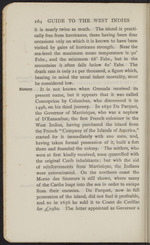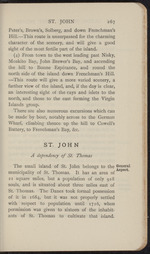| 1 |
 |
“...mind the usual infant mortality, must
be considered low.
History. It is not known when Grenada received its
present name, but it appears that it was called
Concepcion by Columbus, who discovered it in
1498, on his third journey. In 1650 Du Parquet,
the Governor of Martinique, who was a nephew
of D’Esnambuc, the first French coloniser in the
West Indies, having purchased the island from
the French “ Company of the Islands of America,”
started for it immediately with 200 men, and,
having taken formal possession of it, built a fort
there and founded the colony. The settlers, who
were at first kindly received, soon quarrelled with
the original Carib inhabitants; but with the aid
of reinforcements from Martinique, the Indians
were exterminated. On the northern coast the
Morne des Sauteurs is still shown, where many
of the Caribs leapt into the sea in order to escape
from their enemies. Du Parquet, now in full
possession of the island, did not find it profitable,
and so in 1656 he sold it to...”
|
|
| 2 |
 |
“...islets to the
north, and those to the east forming the Virgin
Islands group.
There are also numerous excursions which can
be made by boat, notably across to the German
Wharf, climbing thence up the hill to Cowell’s
Battery, to Frenchman’s Bay, &c.
ST. JOHN
A dependency of St. Thomas
The small island of St. John belongs to the
municipality of St. Thomas. It has an area of
21 square miles, but a population of only 918
souls, and is situated about three miles east of
St. Thomas. The Danes' took formal possession
of it in 1684, but it was not properly settled
with respect to population until 1716, when
permission was given to sixteen of the inhabit-
ants of St. Thomas to cultivate that island.
General
Aspect....”
|
|
